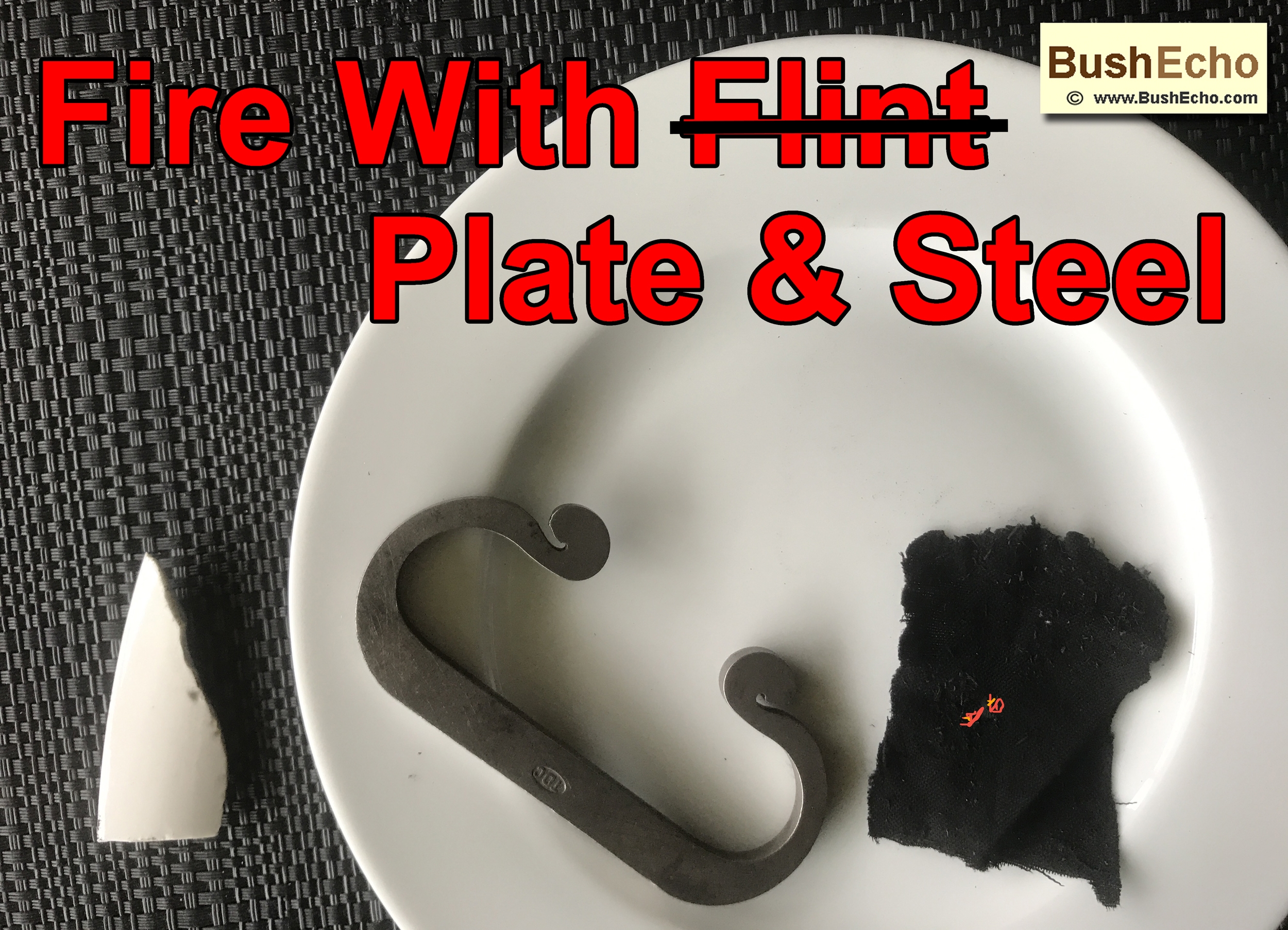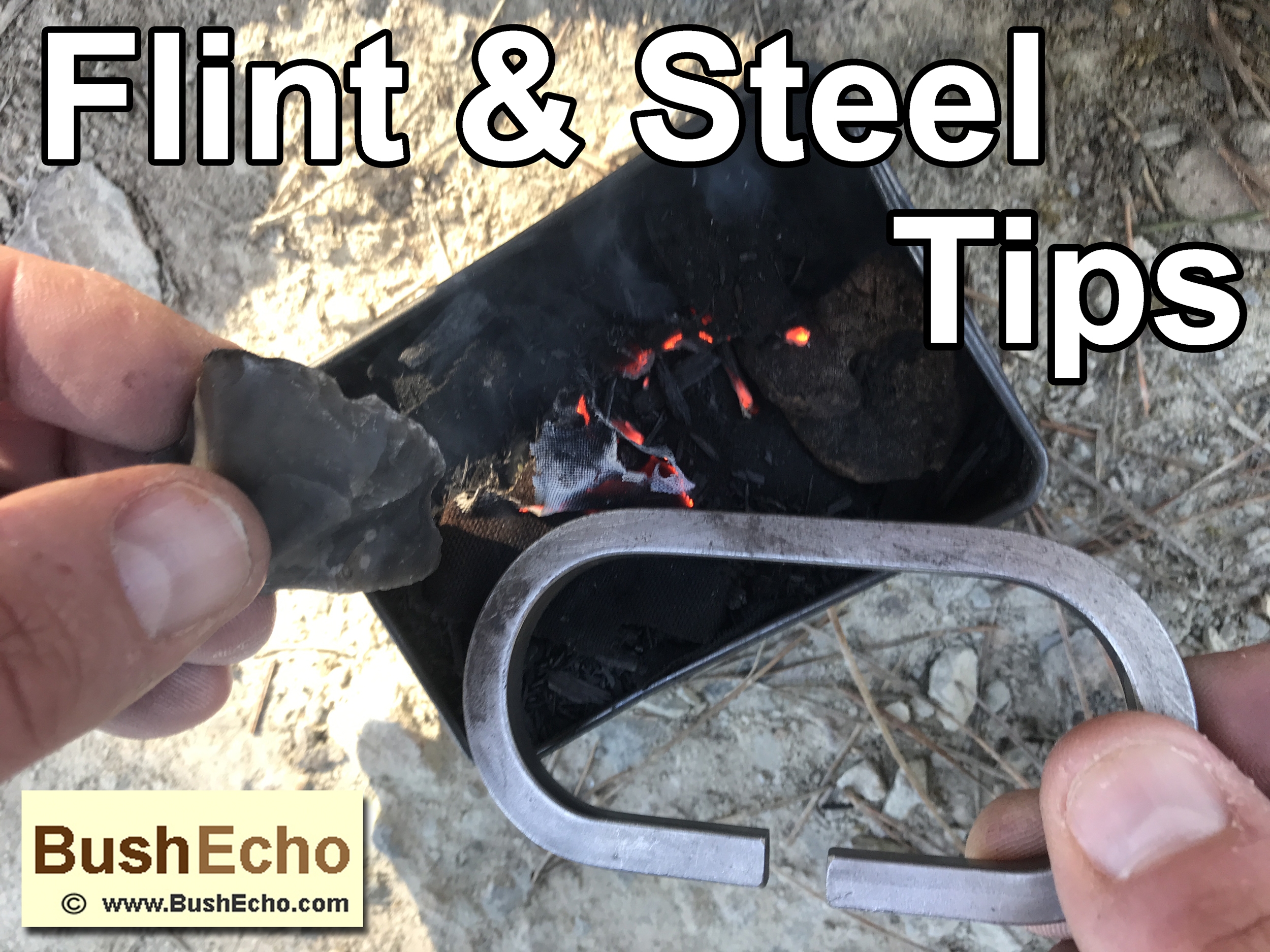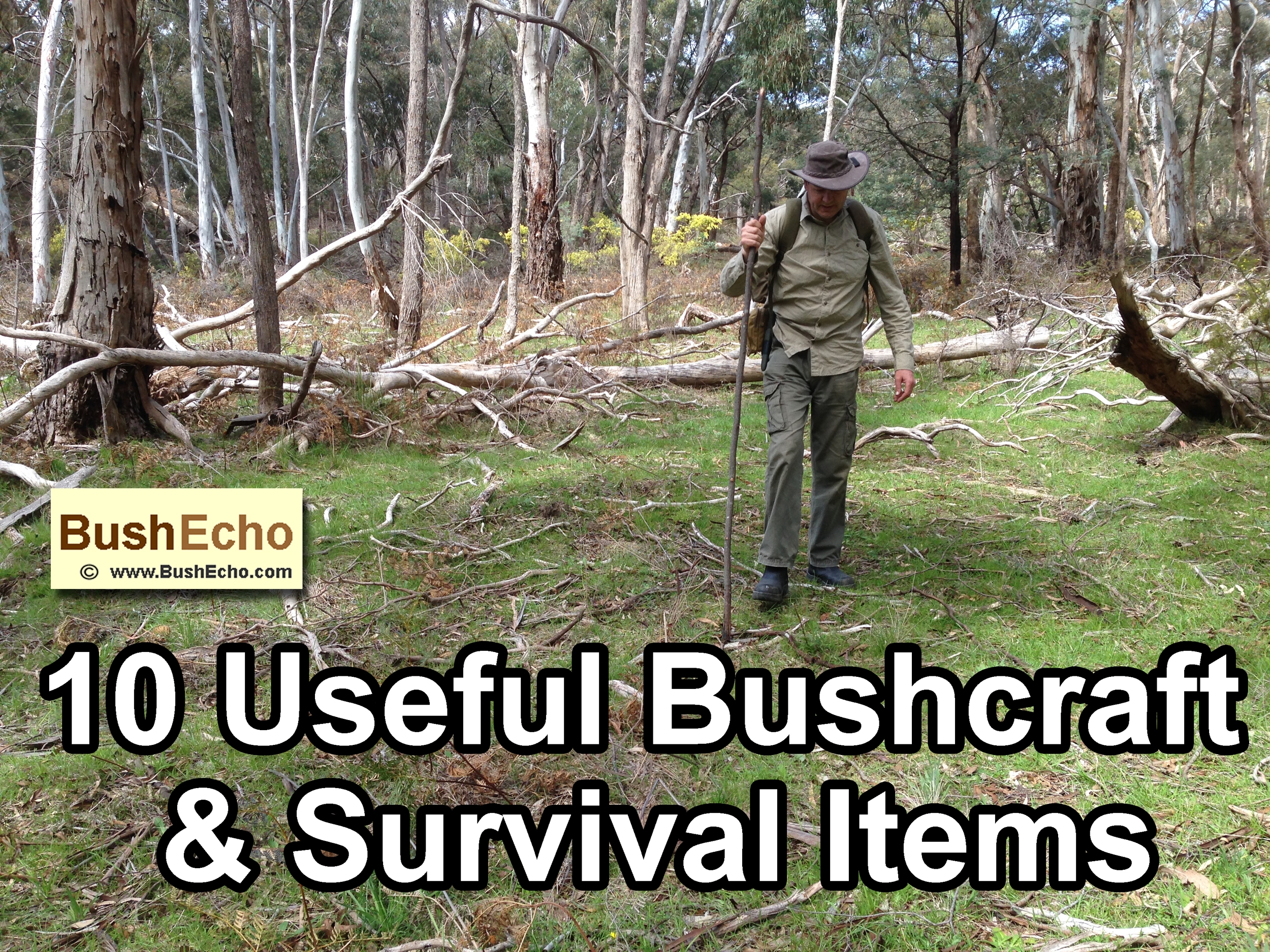Plus the 10 C’s of Survivability and Redundancy.
Layering of bushcraft and survival gear is extremely important. Layering of your kit is basically giving you more options in case you lose a layer, like a pack gets lost or damaged.
(Note: This article is picture heavy, about halfway down article.)
Redundancy and layering.
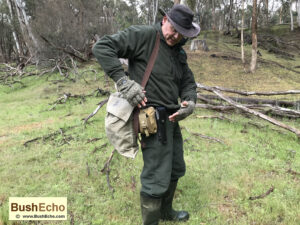
Layering is similar to engineering redundancy, where you have backups of critical items in case something fails. However, layering takes it to the next level. Not only are you thinking about taking extra back up items that are important, (Redundancy.) but how and where to carry them.
While redundancy is vital, there is no sense in having three Bic lighters and a ferrocerium rod in your back pack and you get separated from it.
Consider these two scenarios.
1. What happens if your fishing canoe capsizes and your backpack sinks straight to the bottom? Your fire lighting kit, shelter, knife and spare clothes are in your backpack. Now you are wet, cold and no quick way to start a fire.
Sure you can improvise and collect some materials for a bow drill and a shelter. But that takes a lot of time, local knowledge, skill, resources and energy. There may be no suitable resources around and now your hands are going numb.
2. What happens if you are at a base camp, you go out to collect some firewood. A deer catches your attention, you decide to practice your hunting and stalking skills and see how close you can get to it. It walks away and stops to feed now and then. You follow it for a while and are slowly making ground on it. You are determined to get as close as possible.
Snap, bugger, you stepped on a sick and it alerts the deer. The deer bolts away. You reprimand yourself for being careless. Looking around, you don’t recognize any landmarks or trails, you were too focused on the deer to pay attention were you are.
It hits you, you realize that you are lost. Worst still, you haven’t got your waist bag, which contained your ferro rod, lighter, headlamp, compass / map, mobile phone and poncho. Because it was uncomfortable to sit down at base camp with, you took off your kit.
Before you went out to collect some firewood, you looked at your waist bag and thought, “I’m not going far, and I won’t need that.”
It is now getting dark, you are lost, no map and compass, no warm jacket, no fire kit, no headlamp and no quick and easy way to make a shelter.
Layering your tools.
It is totally up to you on how to layer your gear. But hopefully the importance of layering should be considered.
Here are a couple of layering and redundancy examples:
You might have a cutting tool, such as a fixed blade sheath knife on your belt. A small folding knife or multi tool in your pocket. A folding saw and hatchet in your pack.
Another example is perhaps having, a Bic lighter in your pocket. A flint and steel kit in an Altoids type tin in your belt pouch. Some quality matches like, UCO brand in a waterproof container and a spare lighter in your pack. You now have three layers of fire lighting kit and four redundancy items. This still gives you options if gear fails or gets lost.
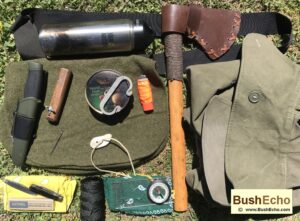
Above picture, some ideas for layering:
1. On body or pockets; Compass with neck lanyard. Pocket knife, Bic lighter and yellow cotton bandana.
2. On Belt; Cold Steel Frontier Hawk tomahawk, Mora Companion Heavy Duty Knife, with ferrocerium rod and sail needle taped to sheath.
3. Slung over shoulder; Asbell Wool Haversack, Klean Kanteen stainless steel 27oz (800mm.), homemade folding saw, bank line, spare pocket knife, Opinel sharpening stone, green bandana, flint and steel kit with charcloth, Canvas rain cape / poncho. (I think it is a World War One, Australian Army rain cape / groundsheet.)
What equipment should we have on us?
The 5 C’s and 10 C’s of survivability, coined by David Canterbury is a great way to think about what is important to take in your kit. These items are indispensable in an emergency wilderness scenario. The first five C’s are essential, the second C’s are very useful to carry.
The 10 C’s does not mean, carry just one item of each category.
Ideally have multiples or redundancy of some items. You could have one main knife, folding saw and a backup blade, like a Swiss Army Knife. Or three sources of fire lighting tools.
It also doesn’t mean that these are the only categories to carry. You might have items that are important tools to your needs or area, like mosquito netting, gill net, spare medication, snow shovel, etc.
The 5 C’s and 10 C’s are a base or starting point of essential items. These are minimal items you might think about carrying, because they are important and can be time consuming or hard to replicate in the woods, depending on resources around.
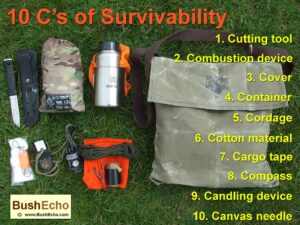
David Canterbury also talks about clothing as being part of the cover element in the 10 C’s. Here are the C’s of survivability:
| 5 C’s and 10 C’s of Survivability. | A few examples of items from the categories. |
| 1. Cutting tool. | Fixed blade knife, pocket knife, folding saw, axe, machete, hatchet, multi tool, buck saw, bow saw. |
| 2. Combustion device. | Lighter, ferrocerium rod, matches, flint and steel, magnesium bar, Fresnel lens. |
| 3. Cover. | Tarp, poncho, quality space blanket, wool blanket. Extra clothing layers. Windproof, waterproof jacket, etc. |
| 4. Container. | Stainless steel water bottle, Billy pot, Army D – cup. |
| 5. Cordage. | Paracord, bank line, micro cord, hootchie cord, twine. |
| 6. Cotton material. | Cotton bandana, shemagh, handkerchief. |
| 7. Cargo tape. | Gorilla tape, duct tape, cloth tape. |
| 8. Compass. | Quality base plate compass, (Spare compass & GPS, phone apps, button compass. Could be backups.) |
| 9. Candling device. | Waterproof head lamp, extra torch, candle, lantern, micro key ring torch. |
| 10. Canvas needle. | Cloth sail needle, heavy duty leather needle, etc. |
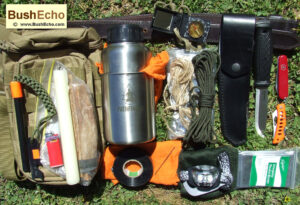
Above picture, some more options for layering which also includes the 10 C’s of survivability:
1. On body or pockets; Compass with neck lanyard. Swiss Army Knife, Bic lighter, space blanket, orange bandana and jute twine.
2. On Belt; Mora Garberg Knife and sheath, with sail needle taped to back of sheath.
3. Slung over shoulder; Pathfinder water bottle bag, that will hold: Tape, bandana, spare knife, larger space blanket, ferro rod, fatwood, candle, cordage, mosquito head net, head lamp and Pathfinder stainless steel 32oz (946 mm.) water bottle with nesting cup.
Options for bushcraft and survival gear layering.

Ideally the 10 C’s, or at least a few of them should be carried on your body. Like in your pocket, or on a lanyard. Or on your belt, like a sheath or belt pouch. However, you are limited with options, as some items are bulky or heavy.
Items like water can be heavy too carry, so a water bottle bag with a shoulder strap, or on your belt, might be an option. Likewise a decent cover like a tarp might be a bit harder to carry. So a haversack, or waist bag could be considered.
Lumbar pack with suspension straps, army webbing with a “H” or “Y” harness, fishing vests, military chest rigs, might be a layered step below your backpack, (Or in addition to it.) but can still carry essential survival items.
Basically carrying items on your person, like in your clothing pockets means less items or less bulkier items can be carried. The advantages are that you have the equipment on you all the time though.
Likewise gear stored at base-camp or a vehicle, can mean it may not be with you in an emergency. But, you can obviously hold or carry more items.
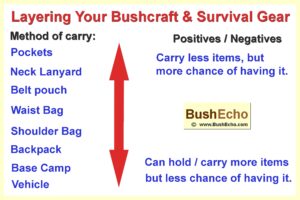
On person, or in pockets of clothing. The first essential layer.
Now we know what gear we might be taking, how we are carrying it, here are some more ideas.
It is not a complete list and I am not saying you should have this or that item. It is just a few ideas on how the layering concept could work. Remembering that we also might have some duplicate and extra survival items in a pouch, satchel and back pack, etc.
However, because this layer is on our person, like pockets, neck lanyard, etc, and we are more likely to have this on us. So, it could be the most important layer as a base, or starting point for our survival kit.
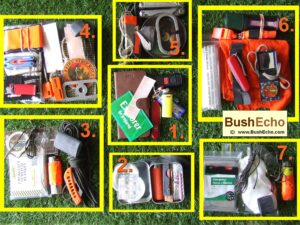 Above picture, seven ideas or options for layering on your person:
Above picture, seven ideas or options for layering on your person:
1. You might have the mobile phone and car keys with you most of the time. So this might be a starting point for your kit. The phone case could hold as an example, Fresnel lens, water purification tablets and some FireStrip Roll for fire lighting.
The car keys might have a mini Bic lighter, a small Swiss Army Knife and key-chain micro torch on it.
2. Altoids type combat survival tin, (Like S.A.S. Survival Handbook, “Lofty Wiseman,” type kit.) Containing a Bic lighter, cotton pads with Vaseline, fish hooks, line, trick birthday candles (More windproof.), water purification tablets, fatwood and small cutting tool. Ranger band to hold lid tight, which can be a flame extender.
3. Cordage, lighter, space blanket, ferro rod, compass, ranger bands and spare pocket knife.
4. Signal mirror, with cover with orange duct tape on it. Ferro rod, Jute twine, water purification tablets, flint & steel, FireStrip Roll, small multi-tool, ranger band and survival card.
5. Flint and steel, charcloth tin, magnesium block and Leatherman tool.
6. UCO Titan matches, whistle, lighter, Swiss Army Knife, compass, cotton bandana, ranger band and survival water holding bags.
7. Space blanket, cutting tool, button compass, lighter, cotton pads with Vaseline, ranger bands and cordage.
Belt pouches, water bottle shoulder carry bags and sheaths.
As well as having some items in your pockets or on a lanyard, a belt pouch and a knife sheath is another layer that you can carry your bushcraft and survival items.
(An extra layer might be a Wazoo Survival Gear cache belt or similar.)
Here are a few more options and ideas for carrying gear.
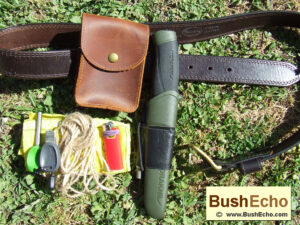 Above pic; Light My Fire, Swedish Firesteel, jute, mini Bic lighter, bandana, leather belt pouch, Mora Companion Heavy Duty Knife, with another ferrocerium rod and sail needle taped to back of sheath.
Above pic; Light My Fire, Swedish Firesteel, jute, mini Bic lighter, bandana, leather belt pouch, Mora Companion Heavy Duty Knife, with another ferrocerium rod and sail needle taped to back of sheath.
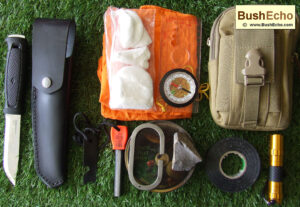 Above picture; Mora Garberg knife and sheath. Belt pouch containing, TBS Fatboy Firesteel, cotton pads with Vaseline, compass, bandana, flint and steel, charcloth tin, tape and torch.
Above picture; Mora Garberg knife and sheath. Belt pouch containing, TBS Fatboy Firesteel, cotton pads with Vaseline, compass, bandana, flint and steel, charcloth tin, tape and torch.
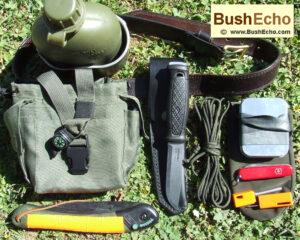 Above image; Kidney shaped army water bottle and cups canteen, button compass, Bacho Laplander folding saw, Mora Garberg knife, cordage, ranger band around an Altoids type survival kit tin, belt pouch, Walker Swiss Army Knife and ferrocerium rod.
Above image; Kidney shaped army water bottle and cups canteen, button compass, Bacho Laplander folding saw, Mora Garberg knife, cordage, ranger band around an Altoids type survival kit tin, belt pouch, Walker Swiss Army Knife and ferrocerium rod.
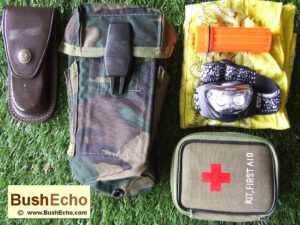 Above; Pocket knife in sheath, USA Army pouch containing first aid kit, bandana, headlamp and matches in waterproof container.
Above; Pocket knife in sheath, USA Army pouch containing first aid kit, bandana, headlamp and matches in waterproof container.
 Above picture; Bowie knife, Leatherman tool, Pathfinder water bottle pouch and kidney style water bottle, button compass, belt pouch, bandana, ferro rod, French Army mess kit containing, SOL Emergency Bivvy Bag and mosquito head net wrapped around a headlamp.
Above picture; Bowie knife, Leatherman tool, Pathfinder water bottle pouch and kidney style water bottle, button compass, belt pouch, bandana, ferro rod, French Army mess kit containing, SOL Emergency Bivvy Bag and mosquito head net wrapped around a headlamp.
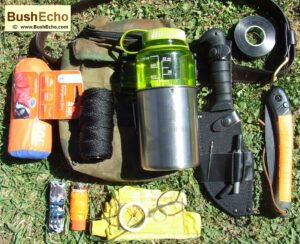 Above image; Emergency SOL bivvy bag, bank line, pouch, nesting cup, Nalgene water bottle, Ka-Bar Warthog fixed blade knife, canvas needle, Hultafors fire steel, tape, Bacho Laplander folding saw, bandana, compass, Bic lighter and torch.
Above image; Emergency SOL bivvy bag, bank line, pouch, nesting cup, Nalgene water bottle, Ka-Bar Warthog fixed blade knife, canvas needle, Hultafors fire steel, tape, Bacho Laplander folding saw, bandana, compass, Bic lighter and torch.
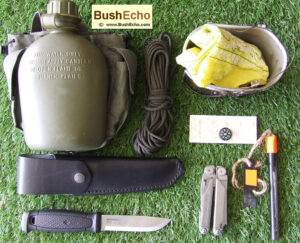 Above picture; Army water bottle and pouch, cordage, cups canteen, yellow bandana, water purification tablets, button compass, ferro rod, Leatherman tool and knife.
Above picture; Army water bottle and pouch, cordage, cups canteen, yellow bandana, water purification tablets, button compass, ferro rod, Leatherman tool and knife.
 Above image; Water bottle pouch, Nalgene water bottle, Pathfinder stainless steel nesting cup, signal mirror, bandana, matches, cordage, leather pouch, flint and steel, charcloth tin, knife, compass and survival water holding bags.
Above image; Water bottle pouch, Nalgene water bottle, Pathfinder stainless steel nesting cup, signal mirror, bandana, matches, cordage, leather pouch, flint and steel, charcloth tin, knife, compass and survival water holding bags.
 Above pic; First aid kit waist bag belt, containing survival water holding bags, small first aid kit, pocket knife, cotton pads and Vaseline, headlamp, whistle, lighter, UCO matches, cordage and bandana. This type of gear could be more of a low key, survival kit.
Above pic; First aid kit waist bag belt, containing survival water holding bags, small first aid kit, pocket knife, cotton pads and Vaseline, headlamp, whistle, lighter, UCO matches, cordage and bandana. This type of gear could be more of a low key, survival kit.
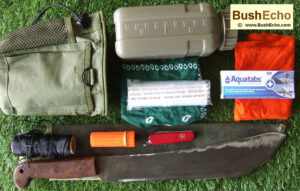 Above pic; Army dump pouch, water bottle, two bandanas, Aquatabs, survival water holding bags, machete, Swiss Army Knife, matches and cordage.
Above pic; Army dump pouch, water bottle, two bandanas, Aquatabs, survival water holding bags, machete, Swiss Army Knife, matches and cordage.
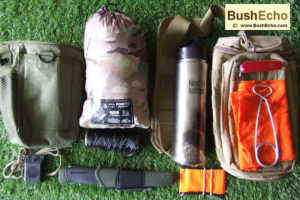 Above; Belt pouch and shoulder strap water bag holder, Helikon poncho, cordage, Klean Kanteen, S.A.K, fish mouth pot holder, bandana, signal mirror with case wrapped in orange tape, knife, and Silva Ranger SL compass.
Above; Belt pouch and shoulder strap water bag holder, Helikon poncho, cordage, Klean Kanteen, S.A.K, fish mouth pot holder, bandana, signal mirror with case wrapped in orange tape, knife, and Silva Ranger SL compass.
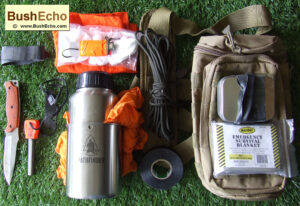 Above picture; Knife, ranger bands, TBS ferro rod, Pathfinder stainless steel water bottle and nesting cup, bandana, lighter and cotton balls, cordage, tape, water bottle bag, “Lofty Wiseman,” S.A.S. survival type kit and space blanket.
Above picture; Knife, ranger bands, TBS ferro rod, Pathfinder stainless steel water bottle and nesting cup, bandana, lighter and cotton balls, cordage, tape, water bottle bag, “Lofty Wiseman,” S.A.S. survival type kit and space blanket.
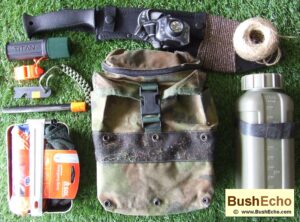 Above picture; UCO Titan matches, whistle, ferrocerium rod, French Army mess kit, SOL Emergency Bivvy Bag, mosquito head, kukri, headlamp, army minimi pouch, roll Jute twine and water bottle.
Above picture; UCO Titan matches, whistle, ferrocerium rod, French Army mess kit, SOL Emergency Bivvy Bag, mosquito head, kukri, headlamp, army minimi pouch, roll Jute twine and water bottle.
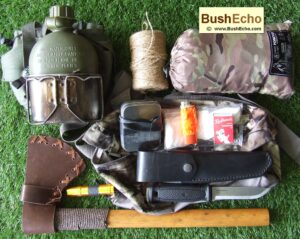 Above pic; Water bottle, pouch and cups canteen, jute twine, Helikon poncho, Altoids survival kit tin with ranger bands, cotton pads with Vaseline, Bic lighter, matches, knife, waist bag, torch and tomahawk.
Above pic; Water bottle, pouch and cups canteen, jute twine, Helikon poncho, Altoids survival kit tin with ranger bands, cotton pads with Vaseline, Bic lighter, matches, knife, waist bag, torch and tomahawk.
Haversacks and shoulder bags.
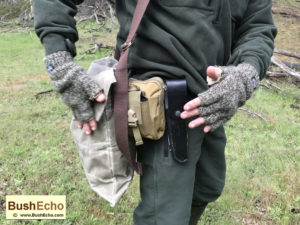
Shoulder carry bags, satchels and haversacks are ideal for carrying additional layers of bushcraft and survival gear, like containers which are bulkier.
Here are some more ideas, remembering you might have some redundancy items in your pockets and on your belt as well.
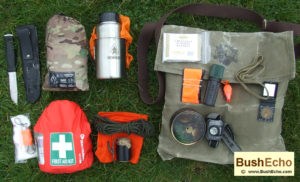 Above image; Mora knife, sheath with canvas needle, poncho, stainless steel water bottle and nesting cup, Mylar emergency blanket, CampCraft Outdoors XL haversack, signal mirror, matches, whistle, compass with mirror, flint and steel tin, headlamp, para cord, jute twine, duct tape, bandanas, first aid kit, cotton wipes with Vaseline and lighter.
Above image; Mora knife, sheath with canvas needle, poncho, stainless steel water bottle and nesting cup, Mylar emergency blanket, CampCraft Outdoors XL haversack, signal mirror, matches, whistle, compass with mirror, flint and steel tin, headlamp, para cord, jute twine, duct tape, bandanas, first aid kit, cotton wipes with Vaseline and lighter.
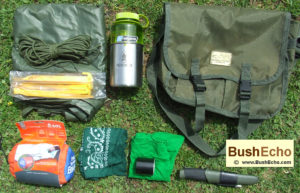 Above picture; Tarp, cordage and tent stakes, Nalgene water bottle with Pathfinder nesting cup, fishing carry bag, Mora Heavy Duty Companion knife, tape, bandanas and thermal bivvy bag.
Above picture; Tarp, cordage and tent stakes, Nalgene water bottle with Pathfinder nesting cup, fishing carry bag, Mora Heavy Duty Companion knife, tape, bandanas and thermal bivvy bag.
Backpacks
The backpack, or daypack can supplement the layering of additional survival gear. Especially the bigger cover element, such as a dedicated sleep system, tent or tarp. Extra cutting and fire lighting tools are also good to layer as well.
So getting to the backpack stage, we know have a few layers of gear already. Like in your pockets, on your belt, perhaps a waist bag or haversack. The backpack supplements bulkier and heavier items well.
Here are some additional options.
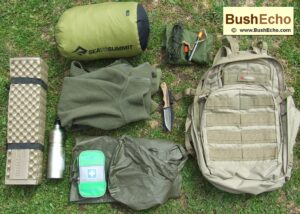 Above image; Thermarest Z-lite sleeping matt, water bottle, sleeping bag with bivvy bag, jacket, German military poncho, first aid kit, spare knife, cordage, fire lighting kit with ferro rod and Caribee Ops 50 liter backpack.
Above image; Thermarest Z-lite sleeping matt, water bottle, sleeping bag with bivvy bag, jacket, German military poncho, first aid kit, spare knife, cordage, fire lighting kit with ferro rod and Caribee Ops 50 liter backpack.
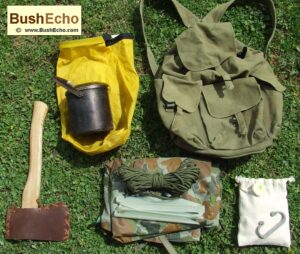 Above image; Hatchet, Zebra Billy pot, dry bag, daypack, Australian Army Hoochie (Tarp.), ridgeline, tent stakes, fire lighting flint and steel kit, with candle.
Above image; Hatchet, Zebra Billy pot, dry bag, daypack, Australian Army Hoochie (Tarp.), ridgeline, tent stakes, fire lighting flint and steel kit, with candle.
 Above pic; Tomahawk, torch, tarp with ridgeline and tent pegs, sleeping gear, water transpiration bags, (Which can also be used as a browse bag / sleeping pad to place materials in it. Or part of a super shelter.) Pathfinder wide mouth water bottle 64oz (1.9 ltr.), snake bite bandage, shemagh and backpack.
Above pic; Tomahawk, torch, tarp with ridgeline and tent pegs, sleeping gear, water transpiration bags, (Which can also be used as a browse bag / sleeping pad to place materials in it. Or part of a super shelter.) Pathfinder wide mouth water bottle 64oz (1.9 ltr.), snake bite bandage, shemagh and backpack.
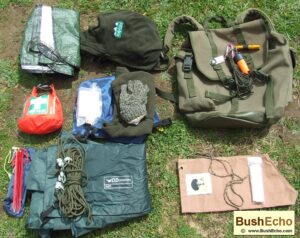 Above image; Grabber All Weather Space Blanket, first aid kit, DD Hammocks tarp 3 x 3m with ridgeline and tent pegs, dry bag, toilet paper, thermal beanie, gloves, Ridgeline Clothing fleece layer, Mil-Tec German Army Mountain Rucksack, carabiner with thermometer, lighter in Exotac FireSleeve, cordage and spare torch, survival water carry bags and Brown’s water filter bag.
Above image; Grabber All Weather Space Blanket, first aid kit, DD Hammocks tarp 3 x 3m with ridgeline and tent pegs, dry bag, toilet paper, thermal beanie, gloves, Ridgeline Clothing fleece layer, Mil-Tec German Army Mountain Rucksack, carabiner with thermometer, lighter in Exotac FireSleeve, cordage and spare torch, survival water carry bags and Brown’s water filter bag.
Vehicles and base camp for storing or carrying extra layers.
Base camp, vehicles, boats, canoes, snow mobiles, ATVs, bikes, sleds, horses, etc., are suited for stowing or carrying heavier camping gear and spare survival items like, larger shelter elements and extra water.
 Above picture; Spare axe and hatchet, shovels, ropes, bow saw, tarps, water containers, vehicle recovery gear and extra blankets.
Above picture; Spare axe and hatchet, shovels, ropes, bow saw, tarps, water containers, vehicle recovery gear and extra blankets.
Carrying extra weight and bulk. Common sense versus Murphy’s Law.
You can overdo redundancy and layering. While Murphy’s Law can throw the unexpected at us, we still have to be mindful of carrying a practical working load, versus being prepared for the worst.
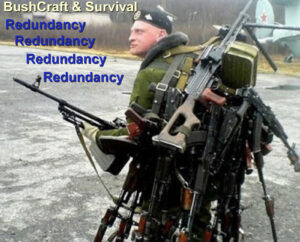
You obviously don’t need to have a neck knife, multi tool and folding knife in your pants pocket. A fixed blade knife, kukri and hatchet on your belt. Extra blade and a folding saw in your fanny pack. A big knife, buck saw and an axe in your back pack. (Unless you want to.)
Bushcraft knowledge, wilderness skills and a correct mindset, can reduce the need for carrying a lot of extra equipment. However, that can come at a price of time, energy used and resources available to make the gear.
What is the probability you will get separated from your gear?
Now it is pretty unlikely you will get separated from your pants and belt containing a belt knife and / or pouch. (Unless you wake up in the middle of the night and get chased by something. Or go to the bush toilet and get lost.)
But it is possible a waist bag, (Fanny pack, bum bag.) or haversack, satchel bag can be taken off and put down.
At base camp or if you are car camping, you might go off and collect some water, go to the bush toilet, a quick hike, or go to your close fishing spot. As you are not travelling far from camp, complacency might be an issue. As these times you are less likely to have a full pack and all your kit with you.
As an example collecting firewood, you might cut yourself bad with an axe, or get bitten by a scorpion when you reach down to pick up some firewood. This is when you might need your gear / first aid kit on you, however, you may not have it on you.
Clothing, the first line of defense.
Layering your clothing has been practiced for many, many years and is the original concept of layering your gear.
Clothing has been mentioned briefly in the 10 C’s, but it goes without saying, you should have appropriate clothing for the environment. Also extra layers for potential nasty weather changes.
That includes hats, beanies, gloves, etc., or whatever clothing is suitable for your conditions. A wind or waterproof jacket should be part of your kit.
“When all things are considered, the act of putting on and taking off clothing in order to adapt to changing environmental conditions is much easier than building a fire or an emergency shelter.”
Surviving Wilderness Emergency, by Peter Kummerfeldt.
Food.
Food is another item that can easily be layered. A high calorie bar, or protein bar in your waist bag can supplement some dehydrated or M.R.E.s in your pack.
First aid kits.

First aid kits can also be layered. You might have a small kit in your pocket, with some important medication, a few large band aids, etc. A larger kit in your day pack, and a more comprehensive first aid kit in your vehicle.
Note: A bandana, needle and duct tape, mirror and magnifying glass on a compass, can also be used as part of the first aid kit.
Summary – Layering your bushcraft and survival kit.
Whether you are a light weight hiker, hunter, fishing in remote places, hardcore woodsman or just camping off the beaten trail, it is worth thinking about layering your gear.

Once again there is no real right or wrong way for everybody. Just a bit of thought of what could happen, while keeping redundancy and layering in mind. So you are not putting all your eggs in the one basket, so to speak.
If you use the 10 C’s as a starting point or guide, think redundancy for added insurance, then consider layering your bushcraft and survival kit. These three concepts, gives you more options to adapt successfully to the circumstances and environment.
Affiliate Links – This article may contain some affiliate product and Amazon affiliate links. This comes at no additional cost to the reader, and helps to support the website. Thank you.
Copyright © by BushEcho. Content on this site cannot be copied and is protected by copyright law. Please contact the author/s for permission.
Disclaimer – This information is for educational purposes only. The author/s and website disclaim liability for any damage, mishap, or injury that may occur from engaging in any activities or ideas from this site.

